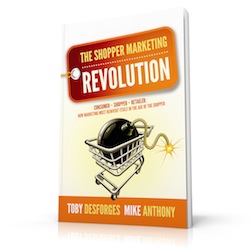There is a lot of debate among shopper marketers as to whether or not ‘disrupting’ shoppers is a good thing. The word ‘disrupt’ gained a lot of credence a few years ago, but it appears now to be falling out of favor. To quote a recent TNS study: “To broaden product consideration and grow sales, category managers and shopper marketers must abandon disruption – and focus on helping shoppers find what they are looking for.”* Is shopper marketing as simple as that: or as shopper marketers or category managers should we be taking a more nuanced approach to influencing shoppers?
The argument against shopper disruption
There are compelling arguments in the ‘against’ camp, and it is easy to see why. Anyone who has ever shopped knows the frustration of pacing a supermarket aisle, searching in vain for a product we can’t find. A shopper who is disrupted is an angry, frustrated shopper and angry, frustrated shoppers are less likely to buy more. Further, while shoppers are searching for the product they want, they aren’t typically open to new ideas. They will, in all likelihood, ignore anything that isn’t what they are searching for. I’m all for making it easy for shoppers to find what they want, and reduce that ‘search time’ that shoppers hate and a shopper marketer can do little with. Where I am less aligned is the extension of this to the argument that shopper marketing is only about making it really easy for shoppers to do what they want.
Sometimes shopper marketers must disrupt shoppers
The trouble with this argument, is that it doesn’t necessarily help shopper marketers. Let’s say a shopper is planning to buy your competitor. As a shopper marketer, we should do what? Put up a sign saying ‘here it is – go buy my competitor?’ Of course not! We want to disrupt them!
I’ll make the leap that most, if not all of the shopper marketers reading this have to grow their business. Correct? OK. For your sales to grow, shoppers have to do something different than they do right now. If shoppers continue to do what they do, then your sales will be flat. Period. Your job is to get shoppers to behave differently. Facilitating shoppers to do what they want to do will only get you so far.
Shopper marketers must strike a fine balance
The reality is that shopper marketing needs to do both. As we position it in workshops, shopper marketers need to make it really easy for the shopper to do what they want to do, but even easier to do what we want them to do. Clearly there are some shoppers we definitely don’t want to disrupt (those might be the ones already buying our brand in large quantities!) So how should marketers get the balance right? There are a number of factors which shopper marketers should consider:
Know your shopper and the category – Sweeping statements and generalizations at this stage are unhelpful. The TNS article* quotes a P&G case from skin care: a high involvement category where a shopper is indeed happy to browse, check and try new things. Under such circumstances the thesis holds true. Shoppers may well happily browse the category after they have found the product they were looking for. I wonder what happened when P&G applied the same logic in, say laundry? Did shoppers linger? I would guess perhaps not.
Understand their current behavior – This helps in two ways. Firstly, we can understand what they do, where they go. This allows is to pinpoint where and how to intercept them much more accurately. It also gives us a clarity on what (unchecked) the shopper would most likely do. How ever our plans work out, we’ll need to check that we haven’t made it too hard for the shopper to complete their ‘desired’ shopping pattern.
Set clear shopper behavior objectives for each shopper segment – Make it clear specifically what behavioral change we are targeting. Be it getting a shopper to switch from a competitor to our brand, or buy two units instead of one: clarity will create focus. Different shopper behavior objectives will lead to different actions. In the skin care case above, the objective might be to get shoppers to try a broader regime of skin care products. Encouraging browsing would therefore be great. If your goal is to switch brands in an inelastic category, more browsing might not be desirable or even possible.
Check that the existing behavior is till ‘easy’ – Before executing, we need to sense-check whether the existing or planned shopping behavior is still relatively easy. If not, we run the risk of dissatisfying shoppers. If possible, we should test, too.
At the heart of this approach, as at the heart of all shopper marketing, is the need to understand shoppers. Not all shoppers are the same, and not are equal. There are some shoppers that are highly planned, some that are not. More critically, there are some whose behavior we wish to change, and some that we do not. To learn more about how to understand shoppers, why not join one of our shopper marketing workshops?
* I’ve quoted a TNS article which you can find here. It is well-worth a read, with the caveats expressed above.
Image: Flickr





